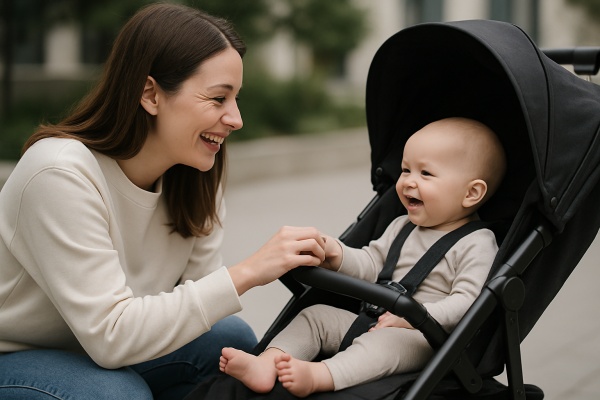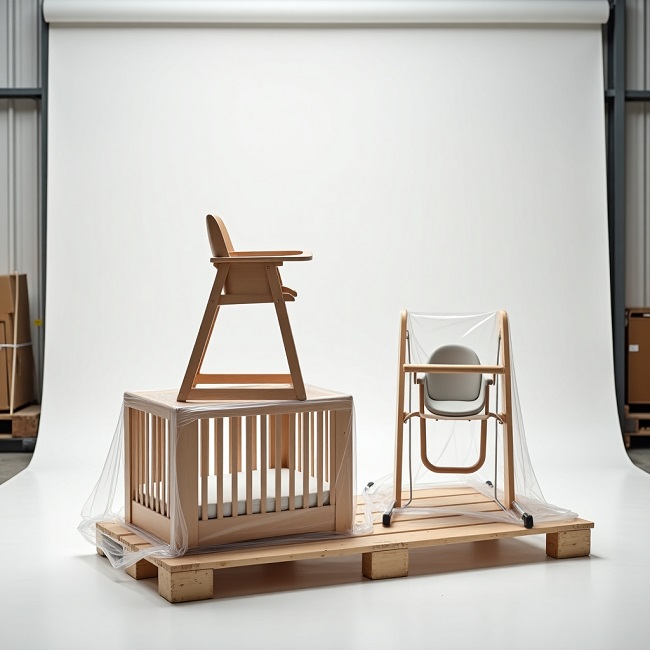Every new parent asks a simple but crucial question: When can a baby sit up in the stroller? The answer is not as clear as just one date. As a parent, your concern for your baby’s safety and comfort is completely fair.
Moving your child from a flat bassinet to an upright stroller seat is a huge milestone. It shows your baby is growing and becoming more independent. However, letting your baby sit up too early can risk their developing neck and spine. In this article, we will delve into this topic together, starting with the fundamentals of a baby’s growth and learning to recognize the “I’m ready” signals their body sends.
How Old Should a Baby Be to Safely Sit in a Stroller?
Many parents begin using an upright stroller seat around the six-month mark, but this timeline can vary significantly from one child to another. The key factor isn’t how many weeks old your baby is, but whether they have achieved the necessary physical strength and control to sit upright with adequate support.
For the first several months of life, a baby’s spine, neck, and head are still developing the strength to maintain an upright position. This is why the American Academy of Pediatrics and other child safety organizations strongly recommend that young infants only ride in a stroller that fully reclines to a flat or near-flat position.
Using a fully reclined stroller from birth is generally considered safe, even for short outings, as long as the infant is properly secured with the harness. However, the transition to a semi-reclined or upright sitting position should be guided by your baby’s individual progress.
Most infants begin to sit with support between 4 to 5 months of age and may start sitting unassisted around 6 to 9 months. This ability is crucial for pushchair use, as sitting up without support indicates that the baby has developed adequate neck and back strength to maintain a seated position safely in a pushchair.
When they can hold their head up steadily without support and demonstrate beginning trunk control, they are likely approaching readiness.
What Developmental Milestones Indicate Stroller Readiness?

Moving beyond a general age range, your baby’s own physical achievements are the most reliable guide to determining when they are ready to sit up in a stroller. These developmental milestones are tangible signs that their muscles and coordination have matured enough to handle a seated position safely.
Strong Head and Neck Control
When you say a baby has “good head control,” it means they can hold their head steady without it bobbing or slumping to the side or forward. You will notice this not just when they are lying down, but also when you hold them upright against your shoulder.
They can lift their head, turn it intentionally from side to side to follow a sound or a toy, and keep it aligned with their spine. This is a clear signal that their neck muscles have developed the necessary strength to prevent their head from falling into a position that could compromise their breathing.
The Ability to Sit with Support
Closely following head control is trunk strength and stability. This means your baby can sit with support—perhaps in your lap or with pillows around them—without curling forward into a C-shape or flopping over.
You might see them using their arms for balance, propping themselves up with their hands on the floor in a “tripod” position. This core strength is what will prevent them from slumping in the stroller seat, which could potentially restrict their breathing.
If you notice they can hold their torso and upper body fairly stable in this supported position, it shows their core and back muscles are getting stronger.
Interest and engagement
Another sign that your baby is ready to sit in a stroller is their interest and engagement with the world around them.
They may exhibit curiosity about what’s happening around them, such as looking around, reaching for objects, or vocalizing with excitement. This interest and engagement indicate that your baby is ready to experience the world from a new perspective and can enjoy the stroller ride comfortably.
Do Different Stroller Types Have Different Age Requirements?
Absolutely. Just as a baby’s needs change as they grow, stroller designs are tailored to support specific developmental stages.
From-Birth Options: Lie-Flat Seats and Bassinets
Strollers that are suitable from birth typically have one of two key features: a seat that can recline to a completely flat position or the ability to attach a separate bassinet (often called a pram or carrycot).
This lie-flat capability is non-negotiable for newborns and young infants who lack head and neck control. It mimics the safety of a crib, ensuring their back is straight and their airway remains open and unobstructed. If your stroller has this feature, you can use it from day one.
Strollers for Older Babies: Fixed Upright Seats
On the other hand, many strollers, particularly some lightweight or umbrella models, have seats that are fixed in a permanently upright or semi-reclined position. These strollers are designed exclusively for older babies who have already met the developmental milestones we discussed earlier—namely, excellent head control and the ability to sit up with minimal assistance.
A Note on Travel Systems and Car Seats
Travel systems, which allow an infant car seat to be clicked directly onto the stroller frame, offer another popular option for the early months. While convenient, it’s important to be mindful of the time your baby spends in the car seat.
Car seats are designed for safety during travel, but they are not intended for prolonged periods of sleep or for use as a primary stroller seat, as the semi-reclined position can sometimes affect a baby’s breathing if they are left in it for too long.
How to Transition from Lying Flat to Sitting Upright?

From lying flat to sitting up, this process doesn’t have to happen all at once. A gradual approach is often the most comfortable and safest for your baby, allowing them to adapt at their own pace.
Start with a Slight Incline
Instead of moving directly from a fully flat position to a 90-degree upright seat, start by using the stroller’s recline function to introduce a slight incline. Raise the back of the seat just one or two notches. Use this semi-reclined setting for short periods during awake and alert walks, perhaps just 10 to 15 minutes at a time.
Observe how your baby responds. Are they comfortable, or do they seem to be slumping to one side? If they look secure and content, you can maintain this semi-reclined position for several outings.
Progress Gradually to a More Upright Position
After a week or two at a slight incline, and as long as your baby continues to show they are comfortable and in control of their head, you can try raising the seat another notch. The key is to make these changes incrementally.
Throughout this process, keep your initial trips short. A 15-to-20-minute walk is a great way to start. This gives your baby a chance to get used to the new posture without becoming overtired.
During this transition period, you should pay close attention to your baby’s cues. If they seem fussy, tired, or are having trouble holding their head up, it’s a sign they’ve had enough for one day. Simply recline the seat back to a more comfortable position or end the walk.
How Can Parents Ensure Their Stroller is Safe and Appropriate?
Manufacturer recommendations: These recommendations are based on extensive testing and understanding of a baby’s developmental needs at various stages. Always review and follow these guidelines before transitioning your baby to a different stroller position or model.
Check the Stroller: Before each use, inspect the stroller for any signs of damage, wear, or malfunction. Ensure that all parts, including the frame, wheels, brakes, and harness, are in good working condition.
Proper positioning: Utilize the stroller’s harness system to keep your baby safely in place, adjusting the straps to fit snugly around their body. Proper positioning also involves aligning the baby’s back and hips comfortably against the stroller seat, preventing slouching or sliding.
Brake Safely: Always engage the stroller’s brakes when stationary, especially on inclines or uneven surfaces. Use both the parking brake and the wheel brakes, if available, to prevent the stroller from rolling away.
Reclining options: Fully reclined positions are ideal for newborns and young infants, while more upright positions can be introduced as your baby gains head and trunk control. Adjusting the recline angle ensures your baby’s safety and comfort during stroller outings.
Sun protection: Many strollers come equipped with sunshades or canopies designed to shield your baby from direct sunlight. Additionally, consider using protective clothing and sunscreen as extra layers of protection, especially during prolonged outdoor activities.
Avoid Hanging Bags: Refrain from hanging heavy bags or purses on the handles of the pushchair, as this can cause it to tip over. Instead, use the pushchair’s storage basket for carrying belongings.
Avoid Unsafe Terrain: Stick to smooth, even surfaces whenever possible, such as sidewalks and paved pathways. Avoid rough terrain, stairs, escalators, and other obstacles that could jostle or tip the stroller.
What If My Baby Doesn’t Like the Stroller?

Adjust the Environment and Timing
Sometimes, a baby’s dislike for the stroller isn’t about the stroller itself, but the circumstances surrounding its use.
Consider the timing of your outings. Is your baby well-fed, rested, and generally in a good mood? A hungry, tired, or overstimulated baby is more likely to be fussy. Try scheduling walks around their nap times or after a feeding.
Also, think about the environment. Is it too sunny, too cold, or too noisy? Adjusting the canopy, adding a blanket, or choosing quieter routes can make a big difference.
Engage and Entertain
If your baby is old enough to sit up and observe, they might simply be bored. Talk to them, point out interesting sights, or sing songs. Attach stroller toys that are within their reach and easy for them to manipulate. A small, unbreakable mirror can also be fascinating for them.
If your stroller allows, facing your baby towards you can also enhance interaction and make them feel more secure, especially during the initial stages of sitting up.
Short Trips and Positive Associations
If your baby consistently fusses, start with very short trips. Even just a five-minute stroll around the block can help them gradually get used to the sensation. The goal is to build positive associations with the stroller over time.
Avoid forcing long rides if they are clearly unhappy, as this can create a negative association that is harder to break. Consistency with short, pleasant outings is often more effective than infrequent, prolonged battles.
Consider Alternative Carriers
If, after trying various strategies, your baby still strongly dislikes the stroller, it might be worth exploring other carrying options for a while. Baby carriers, wraps, or slings keep your baby close to you, which many infants find comforting.
This doesn’t mean you’ve failed with the stroller; it simply means you’re responding to your baby’s individual needs. You can always reintroduce the stroller at a later stage.
Conclusion
The question of when a baby can safely sit in a stroller is one of those nuanced parenting puzzles without a single, universal answer. As we’ve explored, it’s a decision guided not by a date on the calendar but by paying close attention to your child’s unique developmental journey.
From those early days requiring a fully reclined seat for spinal support to the exciting moment they can sit upright, taking in the world around them, each step is a testament to their growth.
Recommended Related Articles:
- How to Choose a Stroller?
- What Kind of Stroller Can I Take on a Plane?
- Stroller Safety Standards: A Complete Guide
- Understand Different Types of Strollers
- What Is a Full-Size Stroller? A Complete Guide
- Best Stroller for Big Kids: A Complete Guide
- Can a Baby Sleep in a Stroller?
- Top 15 Stroller Manufacturers for 2025













